Do you have a question about the Wood-mizer 1987 LT30 and is the answer not in the manual?
Safety precautions for handling bandsaw blades, including protective gear.
Instructions and warnings for setting up the sawmill on various terrains.
Guidelines for safe operation, including guards, safety features, and personal protection.
Safety procedures for electrical checks, maintenance, and operation of electric models.
Table listing belt sizes and part numbers for LT30/LT40 sawmills.
Recommendations for blade types based on engine size and wood type.
Log size capacities and production output for LT30 and LT40 sawmills.
List of available engine/motor options, manufacturers, and model numbers.
Specifications for the physical dimensions and weight of LT30 and LT40 sawmills.
Identification of major components of the Wood-Mizer LT30/LT40 sawmill.
Procedures for setting up a stationary sawmill on firm, level footing.
Detailed steps for setting up a portable sawmill, including outrigger adjustments.
Instructions on how to safely remove and install a bandsaw blade.
Guide on setting the correct tension for the bandsaw blade using the gauge.
Methods to ensure the blade runs true on the wheels using the cant control.
Safety warnings and procedures for starting the sawmill's engine or motor.
Step-by-step guide for loading, turning, and securing logs onto the sawmill bed.
Instructions for operating the up/down mechanism to adjust cutting head height.
How to adjust the blade guide arm for optimal blade support during cutting.
Explanation of the clutch/brake lever function for engaging and disengaging the blade.
How to use the power feed system for moving the carriage forward and backward.
Comprehensive steps for performing cuts on a log, including adjustments and log rotation.
Procedures for edging boards to remove bark and create straight edges.
How to use the blade height scale for accurate lumber thickness.
Instructions for using the water lube system to keep the blade clean.
Steps to properly secure the sawmill for safe transportation.
Estimated life expectancy for common replacement parts with proper maintenance.
Maintenance procedures for lubricating and checking blade guide rollers.
Cleaning procedures for blade wheel housings and checking cam roller position.
Cleaning and lubricating track rails, wipers, and scrapers for smooth operation.
Lubrication schedule for greasable track roller bearings.
Cleaning and lubricating the vertical mast rails with solvent and oil.
Lubrication procedure for up/down and power feed drum switch contacts.
Lubrication tasks for blade guide arms, pivots, and chains.
Lubrication of chrome rods and tensioner screw handle.
Checking and replacing blade wheel belts for wear.
How to adjust the brake strap for proper blade stopping.
Refilling fluid in the drive-side cylinder bearing housing.
Adjusting up/down chain tension and checking gearbox oil level.
Adjusting the power feed belt tension for optimal performance.
Checking mill alignment and ensuring safety warning decals are legible.
Common sawing issues like dull blades, breakage, and tracking problems.
Troubleshooting electrical issues with motors, switches, and battery.
Diagnosing and resolving issues with the power feed system's performance.
Steps for aligning engine/motor and drive pulleys for proper belt operation.
Procedure to test the variable speed switch for jerky responses.
A test to determine if power feed issues are mechanical or electrical.
Detailed mechanical checks for the power feed system to identify issues.
Initial steps and importance of sawmill alignment for cut accuracy.
Setting up the sawmill frame on firm, level ground for proper alignment.
Instructions for installing a blade and aligning blade wheels for proper tracking.
Adjusting nylon pads for smooth saw head movement along the mast.
Procedures to adjust lower track rollers for square cuts and accurate dimensions.
Aligning the main bed rails parallel to the blade for precise sawing.
Adjusting the vertical tilt of the blade guide arm for proper blade support.
Adjusting the horizontal position of the blade guide arm for material width.
Steps to align blade guides for maintaining a straight cut.
Achieving proper blade deflection using the blade guides.
Measuring and adjusting the vertical tilt of the blade guide.
Adjusting the spacing of the blade guides for optimal blade support.
Adjusting the horizontal tilt of the blade guide rollers.
Adjusting side supports horizontally to ensure cut squareness.
Adjusting side supports vertically to ensure they are perpendicular to the rails.
Adjusting clamp stops to ensure proper log clamping.
Adjusting pivot bed rails for cutting long cants.
Compensating for saw head drop when cutting wide logs.
Calibrating the blade height scale for accurate lumber thickness readings.
| Brand | Wood-mizer |
|---|---|
| Model | 1987 LT30 |
| Category | Saw |
| Language | English |

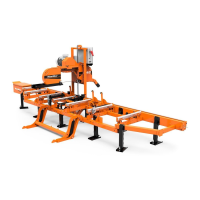




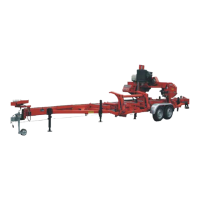
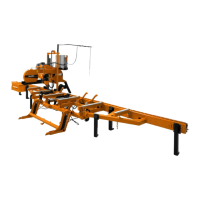

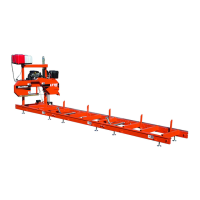

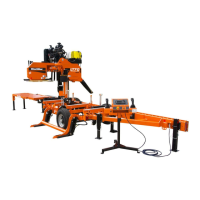
